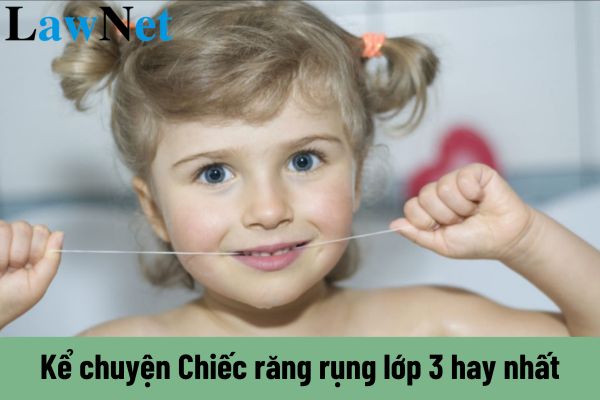What is the sample telling of the story "Chiếc răng rụng" for 3rd-grade students in Vietnam? What content does the 3rd-grade Vietnamese language curriculum cover?
What is the sample telling of the story "Chiếc răng rụng" for 3rd-grade students in Vietnam?
The story "Chiếc răng rụng" is a familiar and interesting lesson in the 3rd-grade Vietnamese language curriculum.
This story is close to the childhood of each of us, bringing much joy and meaning.
Students may refer to the following sample telling of the story "Chiếc răng rụng":
|
What is the sample telling of the story "Chiếc răng rụng" for 3rd-grade students in Vietnam? One beautiful morning, a boy named Nam was having breakfast with his family when he suddenly felt that his front tooth was quite loose. Nam touched it, and to his surprise, his tooth was wobbly. He was extremely worried, not knowing what to do. Nam immediately ran to his mother and asked: "Mom, my tooth is loose, is there something wrong with it?" |
*Note: The information is for reference only./.

What is the sample telling of the story "Chiếc răng rụng" for 3rd-grade students in Vietnam? What content does the 3rd-grade Vietnamese language curriculum cover? (Image from the Internet)
What content does the 3rd-grade Vietnamese language curriculum cover?
Under sub-section 2, Section V of the General Education Program for Literature issued with Circular 32/2018/TT-BGDDT, the 3rd-grade Vietnamese language curriculum covers the following content:
* Vietnamese Knowledge
- How to write document titles
- Vocabulary based on themes
- Words with similar meanings and words with opposite meanings
- Words indicating objects, actions, qualities
- Basic understanding of narrative sentences, questions, commands, and exclamatory sentences: characteristics shown through punctuation, markers of sentence types, and the function of each type of sentence
- Usage of the dash (placed at the beginning of a line to indicate direct speech by a character); quotation marks (to mark a direct quote or dialogue); colon (signals a list or explanation)
- Comparative literary devices: features and effects
- Basic understanding of paragraphs and multi-paragraph texts: identification signs
- Basic understanding of turns in group exchanges
- Text types and genres
+ Paragraph retelling a story read or an action completed
+ Paragraph describing an object
+ Paragraph sharing emotions and feelings
+ Paragraph explaining why one likes a character in a story
+ Paragraph introducing an object, narrative text about a phenomenon consisting of 2 - 3 events, short notices or news briefs, pre-printed forms
- Information through images, data (non-verbal communication tools)
* Literature Knowledge
- Lessons derived from the text
- Location and time
- Character thoughts and actions
* Data
(1) Literary Texts
- Folktales, fables, short stories; descriptive passages (articles)
- Poems, folksongs, proverbs, rhymes
Text length: stories about 200 - 250 words, descriptive texts about 180 - 200 words, poems about 80 - 100 words
(2) Informational Texts
- Text introducing an object, narrative text about a phenomenon consisting of 2 - 3 events
- Short notices, pre-printed forms
Text length: about 120 - 150 words.
What are the specific competencies required after completing the 3rd-grade Vietnamese language curriculum?
Under Section IV of the General Education Program for Literature issued with Circular 32/2018/TT-BGDDT, the specific competencies required after completing the 3rd-grade Vietnamese language curriculum include:
[1] Required Language Competency:
- Read accurately, fluently, and expressively; understand the main content of the text, primarily explicit content; begin to understand implicit content such as themes, lessons from the text.
- For students in grades 3, 4, and 5, focus more on the requirement to understand specific content, understand themes, and lessons drawn from the text.
- From grade 1 to grade 3, write with correct spelling, vocabulary, and grammar; write some sentences, short paragraphs; in grades 4 and 5, start writing complete short essays, mainly narrative, descriptive essays, and simple introductions.
- Write texts retelling stories read, events witnessed, participated in, imagined stories; describe familiar objects and phenomena; introduce objects and activities close to students' lives.
- Write paragraphs expressing the emotions and thoughts of students when reading a story, poem, witnessing an event that evokes emotions; give opinions on a simple topic in studies and life; write some forms of texts such as: autobiographies, messages, invitations, schedules, applications,...; initially learn to write in a process; the composition needs to have all three parts (introduction, body, conclusion).
- Clearly present ideas and feelings; begin to use appropriate gestures and posture while speaking; clearly recount stories read or heard; share and exchange feelings, attitudes, thoughts on discussed issues; know how to explain a subject or simple process.
- Understand with an appropriate attitude and grasp the basic content; recognize the speaker's emotions; know how to respond to what has been heard.
[2] Required Literary Competency:
- Distinguish between narrative texts and poems (prose and verse); identify the content of the text and the writer's attitude and feelings; begin to understand the effects of some formal elements of literary texts (language, characters, plot, verse, metaphor, personification). Know how to relate, imagine, and express literary aspects in writing and speaking.
- For students in grades 3, 4, and 5: understand literary texts expressively; recount or summarize the main content of stories, poems; comment on characters, events, and the author's attitude and feelings in the text; recognize time and place, some poetic meters, rhythms, beautiful or unique words, images, and the effects of personification, comparison as literary devices.
- Understand the meaning or lesson derived from the text. Write narrative or descriptive paragraphs expressing emotions and imaginative capabilities.

